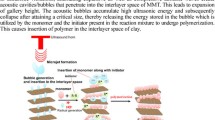Abstract
The present study aimed to develop an effective oral formulation of tranilast (TL), a poorly soluble anti-inflammatory drug, via the formation of drug complex with 3-aminopropyl functionalized magnesium phyllosilicate (AMP clay) and improve the pH-dependent drug dissolution and bioavailability of TL. The drug-clay complex (TL-AMP complex) was prepared by co-precipitation method and its structural properties were characterized by X-ray powder diffraction, Fourier transform infrared spectroscopy and transmission electron microscopy. The dissolution profiles of TL-AMP complex were evaluated at different pHs. The formation of TL-AMP complex significantly improved the dissolution rate as well as the extent of drug release at acidic pHs, while the dissolution of untreated TL was negligible at pH 1.2 and 4.0. TL-AMP complex also achieved faster drug release than untreated drug (about 90 vs 30 % within 30 min) at pH 6.8. After oral administration to rats, TL-AMP complex enhanced significantly (p < 0.05) oral drug exposure and increased Cmax and AUC by six- and threefolds, respectively, compared to untreated TL. In conclusion, TL-AMP complex may be promising to improve the pH-dependent dissolution as well as bioavailability of TL.





Similar content being viewed by others
References
Han, H.K., Y.C. Lee, M.Y. Lee, A.J. Patil, and H.J. Shin. 2011. Magnesium and calcium organophyllosilicates: synthesis and in vitro cytotoxicity study. ACS Applied Materials and Interfaces 3: 2564–2572.
Holmström, S.C., A.J. Patil, M. Butler, and S. Mann. 2007. Influence of polymer co-intercalation on guest release from aminopropyl-functionalized magnesium phyllosilicate mesolamellar nanocomposites. Journal of Materials Chemistry 17: 3894–3900.
Izumi, K., A. Mizokami, Y.Q. Li, K. Narimoto, K. Sugimoto, Y. Kadono, Y. Kitagawa, H. Konaka, E. Koh, and E.T. Keller. 2009. Tranilast inhibits hormone refractory prostate cancer cell proliferation and suppresses transforming growth factor β1-associated osteoblastic changes. The Prostate 69: 1222–1234.
Kawabata, Y., K. Yamamoto, K. Debari, S. Onoue, and S. Yamada. 2010. Novel crystalline solid dispersion of tranilast with high photostability and improved oral bioavailability. European Journal of Pharmaceutical Sciences 39: 256–262.
Mann, S., S.L. Burkett, S.A. Davis, C.E. Fowler, N.H. Mendelson, S.D. Sims, D. Walsh, and N.T. Whilton. 1997. Sol-gel synthesis of organized matter. Chemistry of Materials 9: 2300–2310.
Martin, J.E., A.J. Patil, M.F. Butler, and S. Mann. 2011. Guest-Molecule-Directed Assembly of Mesostructured Nanocomposite Polymer/Organoclay Hydrogels. Advanced Functional Materials 21: 674–681.
Nie, L., Y. Oishi, I. Doi, H. Shibata, and I. Kojima. 1997. Inhibition of proliferation of MCF-7 breast cancer cells by a blocker of Ca2+-permeable channel. Cell Calcium 22: 75–82.
Noguchi, N., S. Kawashiri, A. Tanaka, K. Kato, and H. Nakaya. 2003. Effects of fibroblast growth inhibitor on proliferation and metastasis of oral squamous cell carcinoma. Oral Oncology 39: 240–247.
Onoue, S., Y. Kojo, H. Suzuki, K. Yuminoki, K. Kou, Y. Kawabata, Y. Yamauchi, N. Hashimoto, and S. Yamada. 2013a. Development of novel solid dispersion of tranilast using amphiphilic block copolymer for improved oral bioavailability. International Journal of Pharmaceutics 452: 220–226.
Onoue, S., K. Yamamoto, Y. Kawabata, and S. Yamada. 2013b. In vitro/in vivo characterization of nanocrystalline formulation of tranilast with improved dissolution and hepatoprotective properties. European Journal of Pharmaceutics and Biopharmaceutics 85: 952–957.
Patil, A.J., E. Muthusamy, and S. Mann. 2004. Synthesis and self-assembly of organoclay-wrapped biomolecules. Angewandte Chemie (International Edition in English) 43: 4928–4933.
Patil, A.J., M. Li, E. Dujardin, and S. Mann. 2007. Novel bioinorganic nanostructures based on mesolamellar intercalation or single-molecule wrapping of DNA using organoclay building blocks. Nano Letters 7: 2660–2665.
Patil, A.J., and S. Mann. 2008. Self-assembly of bio–inorganic nanohybrids using organoclay building blocks. Journal of Materials Chemistry 18: 4605–4615.
Tamai, H., O. Katoh, S. Suzuki, K. Fujii, T. Aizawa, S.I. Takase, H. Kurogane, H. Nishikawa, T. Sone, K. Sakai, and T. Suzuki. 1999. Impact of tranilast on restenosis after coronary angioplasty: tranilast Restenosis Following Angioplasty Trial (TREAT). American Heart Journal 138: 968–975.
The Society of Japanese, P. 2002. Tranilast. Japanese Orange Books No. 12 (Approved drug products with therapeutic equivalence evaluations).
Tran, P.H.L., H.T.T. Tran, and B.-J. Lee. 2008. Modulation of microenvironmental pH and crystallinity of ionizable telmisartan using alkalizers in solid dispersions for controlled release. Journal of Controlled Release 129: 59–65.
Yang, L., S.-K. Choi, H.-J. Shin, and H.-K. Han. 2013. 3-Aminopropyl functionalized magnesium phyllosilicate as an organoclay based drug carrier for improving the bioavailability of flurbiprofen. International Journal of Nanomedicine 8: 4147–4155.
Acknowledgments
This research was supported by Basic Science Research Program through the National Research Foundation of Korea (NRF) funded by the Ministry of Education (NRF-2013R1A1A2061289), by a grant of the Korean Health Technology R&D Project, Ministry for Health & Welfare (A092018) and by the Bio & Medical Technology Development Program of the National Research Foundation (NRF) funded by the Korean government (MEST) (Number 2012053532).
Author information
Authors and Affiliations
Corresponding author
Rights and permissions
About this article
Cite this article
Yang, L., Shao, Y. & Han, HK. Preparation and in vitro/in vivo characterization of tranilast-AMP clay complex for improving drug dissolution and bioavailability. Arch. Pharm. Res. 37, 1554–1559 (2014). https://doi.org/10.1007/s12272-014-0458-6
Received:
Accepted:
Published:
Issue Date:
DOI: https://doi.org/10.1007/s12272-014-0458-6




